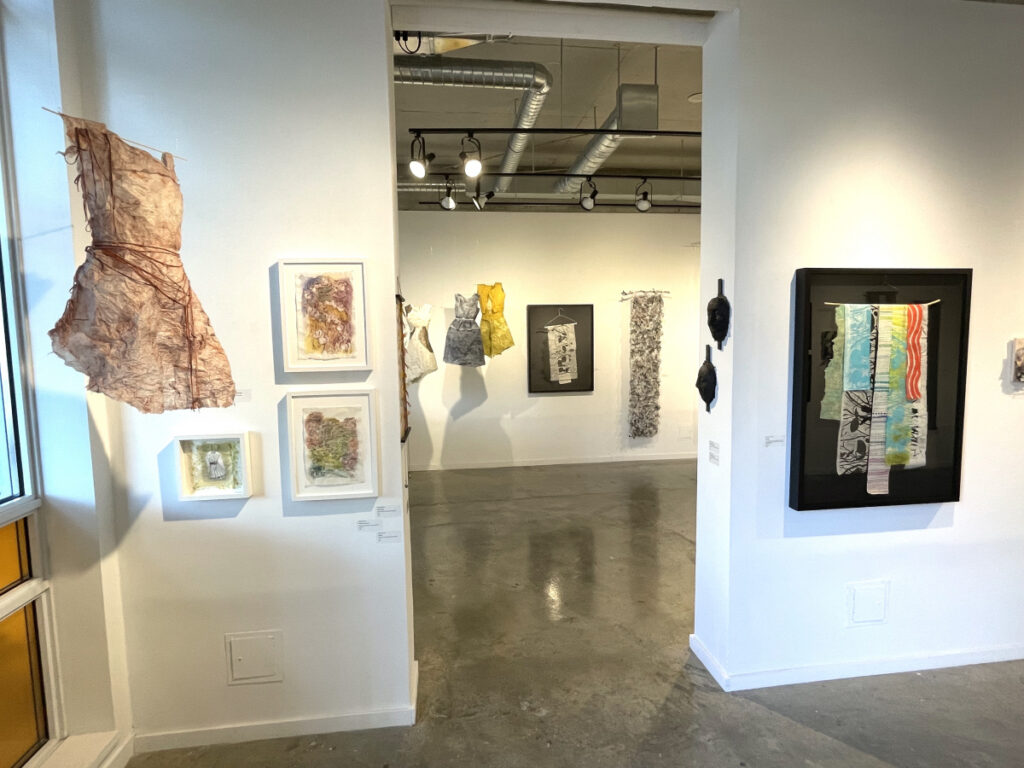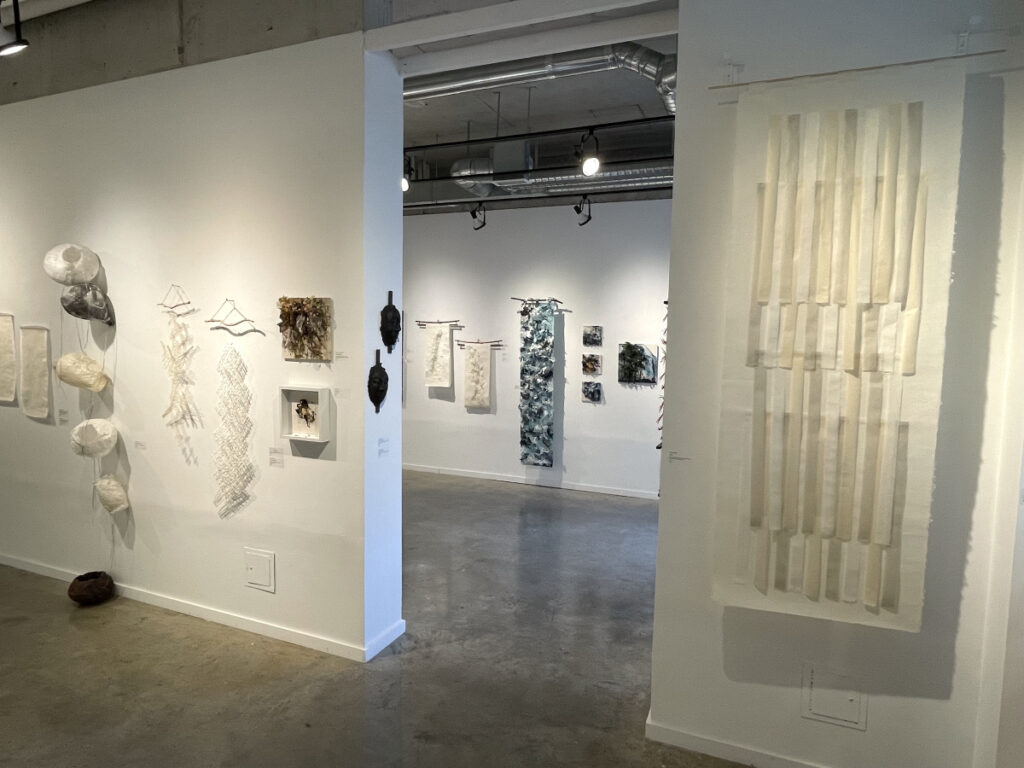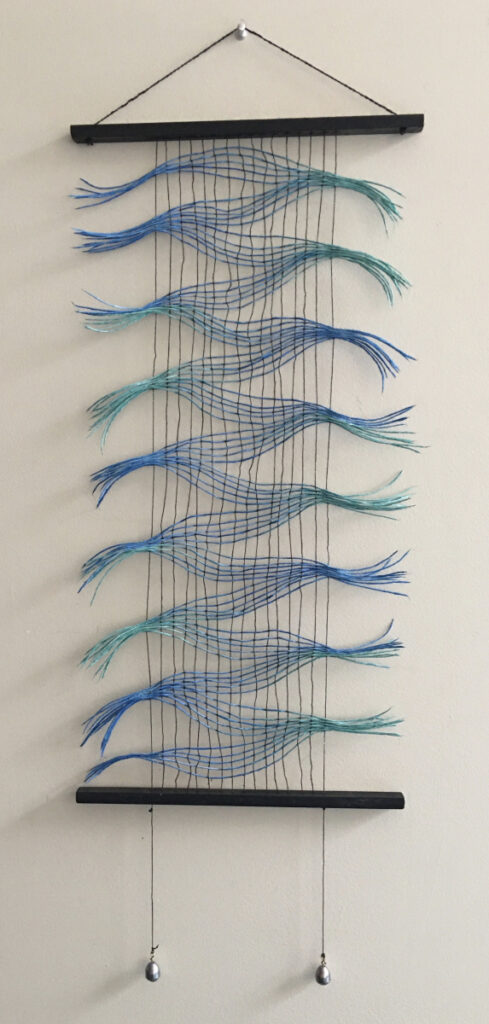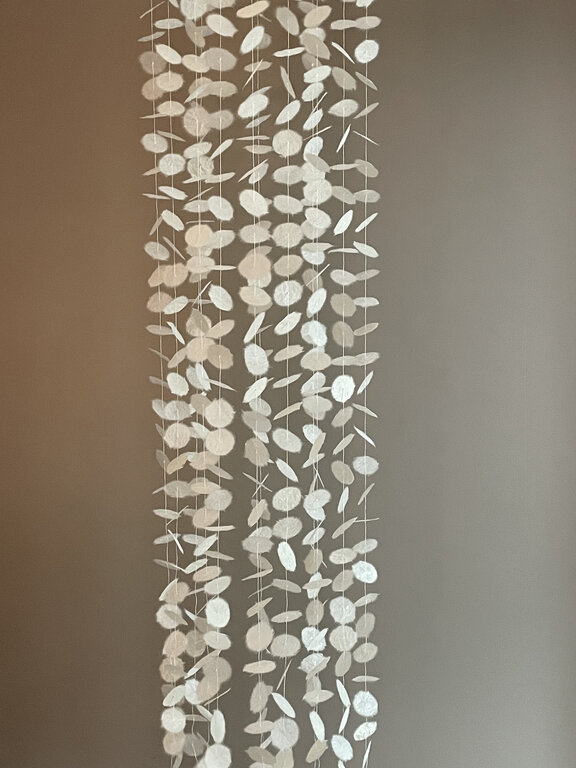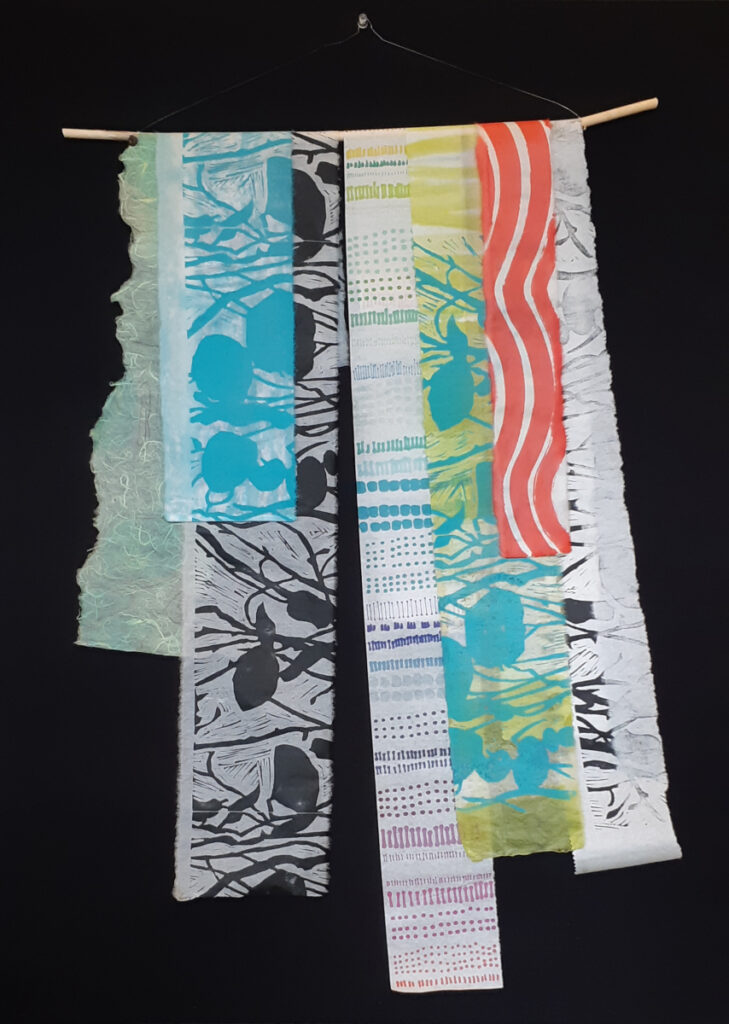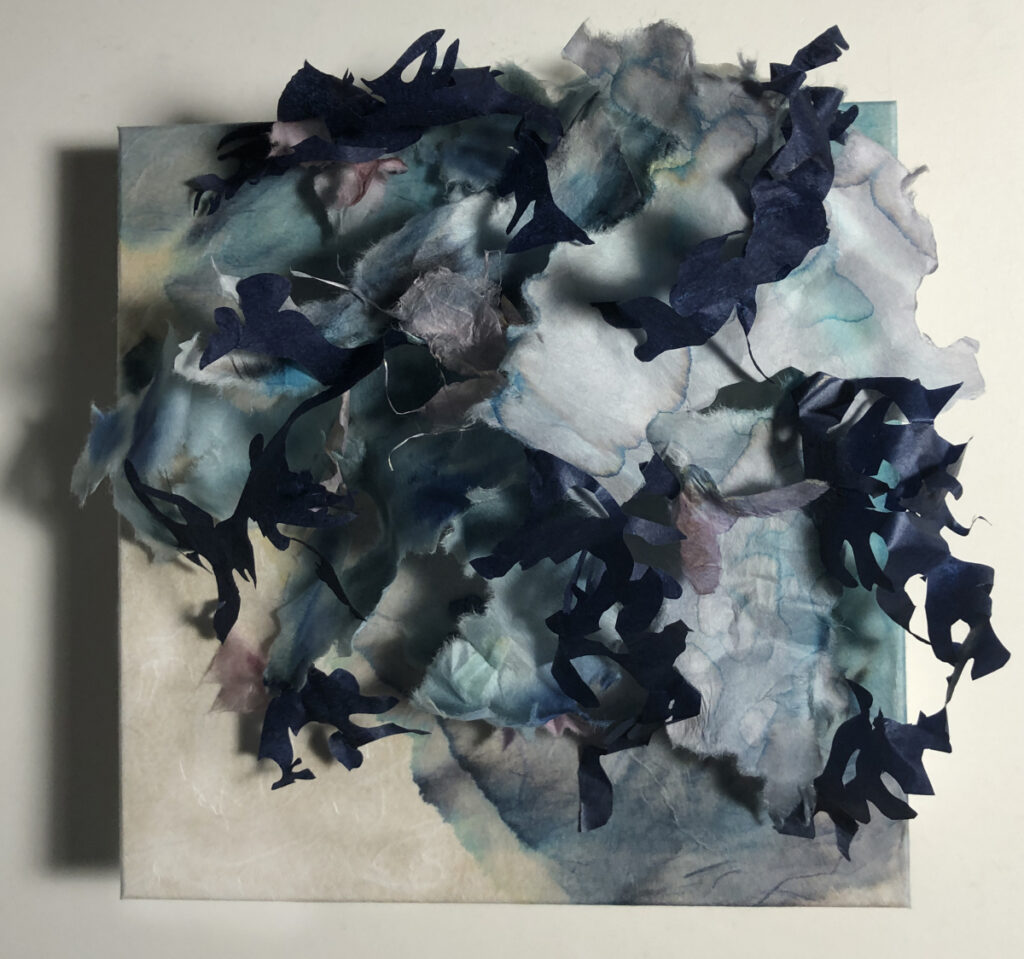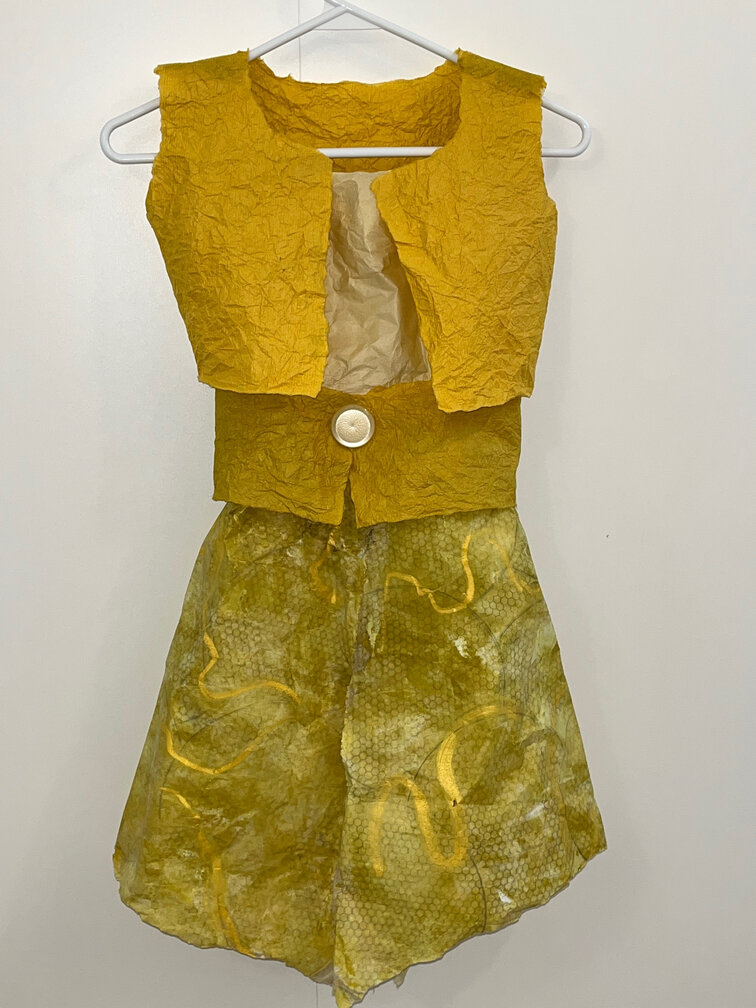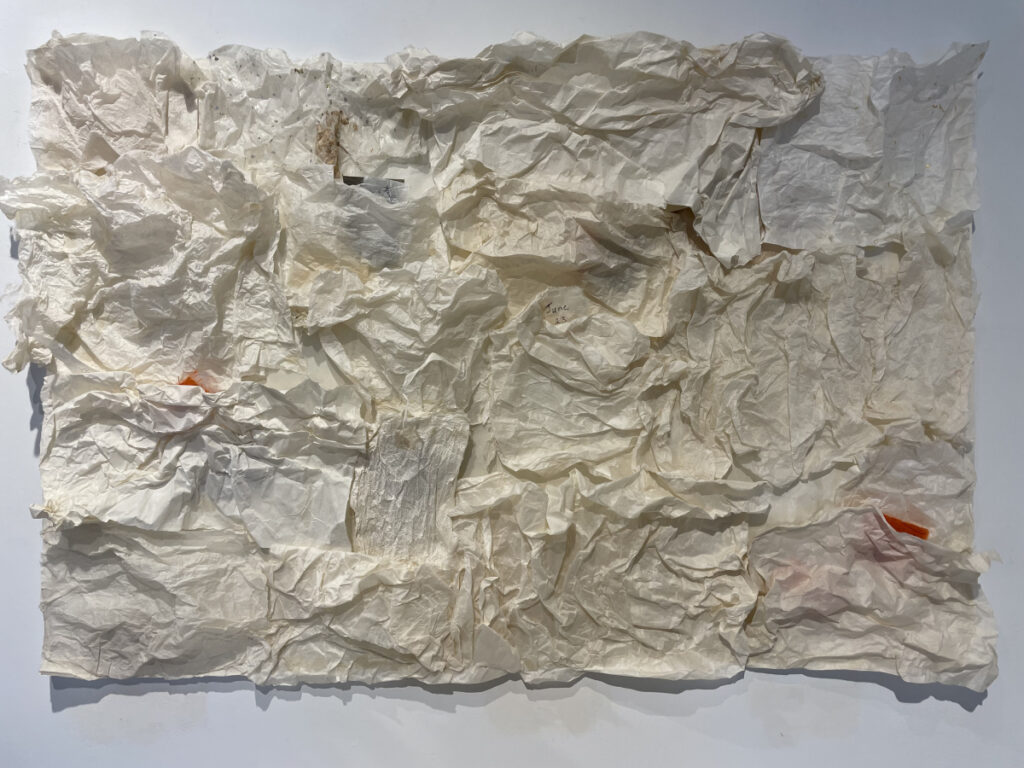The journey: Where it Began
Exploring a tradition of hundreds of years and intermingling it with 6 individual artistic practices would lead you to Propeller Art Gallery in Toronto and their current exhibition, Washi Sisters: A journey. In 2019 an exhibition by The Japanese Paper Place and Propeller Art Gallery, titled The Promise of Sekishu Washi, featured 39 artists, including several members of the, now collective group, the Washi Sisters. Thus, the connections grew and formed. As the COVID-19 pandemic surged, the collective met via Zoom meetings, sharing their experiences and practices of using the traditional material, Washi paper.
Installation view of the Washi Sisters: A journey at Propeller Art Gallery
This Japanese paper is made by hand from three plant barks: kozo, mitsumata and gampi, originally used by Buddhist monks for calligraphy writing in 610. The branches of the trees are cut, cooked, stripped, pressed and left to dry before becoming the type of Washi paper we know and see used in the Washi Sisters exhibition. Each sister has experimented and journeyed down their own paths to meet in the middle for this show, demonstrating varying techniques and skills which they have developed over years of practice. Propeller Art Gallery was given video recorded access to the behind-the-scenes processes which each artist uses to create their pieces for this show. As a collective, most of the artists experiment with konnyaku, a powdered substance which forms a glue when mixed with warm water. This substance, when added to the Washi paper, allows for the molding of the paper when wet, holding it into the many forms we see in the exhibition.
Installation view of the Washi Sisters: A journey at Propeller Art Gallery
The Artists
We begin with Noriko Yamamoto, whose work, Sora, in The Promise of Sekishu Washi, received an Honorable Mention and an Audience Choice Award. Continuing her practice of using Washi papers, she created works varying from masks to Washi tied with copper wires hanging on the walls. Yamamoto’s career as a dancer and silent storyteller inspired the emotive dance performed on opening night of the exhibition at Propeller, The Crane. Wearing a dress made of Heritage Washi, she used her body to express the delicate yet strong, calm yet expressive nature of Washi paper. She is known to use nature and the human body as sources of inspiration, therefore combining the two in performance brought together two sides to her journey of experimentation through a traditional medium.
Noriko Yamamoto, Wavelets #1, String, pigment, wood, acrylic gel, sinker on Sekishu Banshi with konnyaku, 30.5 x 12″
Susan Ruptash finds herself inspired by the individual fibers and translucency of the Washi paper, using it to create forms and shapes resembling the most fantastical of creations. Though self-described as minimalistic pieces, her works in the exhibition each tell individual stories, while showing respect to their natural materials. Her piece 2292 is an example of the expression of the individual kozo fibers of the Washi paper while also providing us with a calendar. 2292 hangs from the ceiling in a resemblance to windchimes, with each strand representing a month from the year 2021; each circle having been made a day from each month. Also having a love for numbers, she titled the piece after calculating the circumference of each circle and multiplying it by 365.
Susan Ruptash, 2292, Sekishu Mare and Sekishu Banshi with linen thread, 74 x 18 x 18″
The artist wrote, “The piece itself is a commentary on how each day in a year seems the same yet each day deserves to be recognized and celebrated.” Her practice is an homage to the beauty and importance of nature’s creations, celebrating and highlighting their smallest details through Heritage Washi.
Dominique Prevost began using Washi paper in 2008 after the owner of The Japanese Paper Place, Nancy Jacobi, provided her with some sample sheets. It was “love at first sight and touch”, as she describes. Prevost experiments with Washi, allowing it to inspire the movement, direction and depth of her artworks. She even refers to Washi as one of her “studio collaborators”. In the Washi Sister Process Video (found on the Propeller Art Gallery web page), she demonstrates a Japanese Suminagashi technique of using multiple brushes to add coloured pigment and drops of dish soap to a basin of room temperature water, before adding the Washi paper on top to soak. Once removed from the basin, the Washi paper reveals a series of colourful forms, which the artist then rearranges to create her pieces for Washi Sisters: A journey. When asked how she decides to rearrange her pieces, she talked about Regalia, stating that, “In my studio, I hang some of my translucent artworks to see how their colours and patterns interact. Over time, I have grown very fond of that way of suspending layers. It’s an ode to daily rituals, the care we take in humble tasks, folding garments, pairing textures and colours. Regalia is like a proud accoutrement, showing its true colours!”
Dominique Prévost, Regalia, Sumi ink, felt pen, acrylic, suminagashi, lino print, wood, guitar string on Sekishu Banshi, Unryu, and Shodo Tosa Gasen, 40 x 30 x 2″
Sharron Corrigan Forrest was introduced to Heritage Washi many times in her artistic career. From fellow experiences of artists, co-curating the The Promise of Sekishu Washi exhibition and taking Washi paper making workshops in Japan, she now uses Washi as a visually expressive format to engage with natural resources. Some of her works, such as Blue Water tie in the memories of time spent outdoors in Northern Ontario while Lake Meditation acts as a sculptural relief in response to the topographical features of that region. She uses varying colours and sculptural processes (made entirely from Washi and konnyaku) to help guide her as she makes her pieces through various techniques. Like several of the Washi Sisters, Corrigan Forrest believes she is constantly learning from experimenting with Washi paper in her art practice. In order to tell the stories of her pieces, she plays with the lighting and the structure of her works to keep it as natural as possible while also applying a natural colour palette. She aims to demonstrate a deep appreciation for her memories and the natural world.
Sharron Corrigan Forrest, Blue Water, Water-based inks with Oguni Snowbleached, Tama, Unryu, Obonai Washi, Konnyaku, 8 x 8 x 3.5″
From a different approach, Sharon Dembo began experimenting with Washi through printmaking. Inspired by the art of dance, she saw Heritage Washi as a way to translate movement into 3-D forms. In seeing how Washi took to coloured inks and encaustic pigments, Dembo began working with a metal mannequin to create some of her pieces for this exhibition. Her work Beehive was made using a honeycomb imprint on the Washi kozo paper, using a technique called frottage or rubbing onto the paper’s surface. Adding the yellow pigment onto a Hotbox, the paper was placed on top and then removed quickly to get the colour and textures we see in her works.
Sharon Dembo, Beehive, Matsuo Kozo Deep Gold, Green, Fukunishi Udagami with encaustic printing, 32 x 21 x 10″
Works such as Corals and Gathering were made with a similar rubbing technique but in Costa Rica, with rubbing against stone surfaces. Dembo wanted to see the response of the Washi paper to conte and watercolor, so continued experimenting with both. All these techniques can be admired throughout her pieces in Washi Sisters: A journey.
Bunni (Barbara) Bresver is the only artist out of the six who did not partake in the original Washi exhibition at Propeller, The Promise of Sekishu Washi in 2019. However, she is just as much an experimenter and artist of Heritage Washi as her sisters. Heavily influenced in her practice by Japanese brush paints and calligraphy, Bresver uses the medium of paper to fabricate books, boxes and other sculptural pieces entirely from Washi paper. Her advice to other experimenters of Washi: never throw away anything! She believes in keeping leftover torn or tattered pieces for later use, stating that you never know when you may need them again. Her work Endurance is an example of this idea. It was made by accident with a candle lighter over her kitchen sink. Meaning only to burn the edges slightly, the work suddenly became engulfed in flames. What remained of the paper was pieced back together to make what we now see in the exhibition. Bresver is inspired primarily by memories. Her work, Wall of Memories, is an interactive homage to individual memories, asking viewers to write down a name, a place or a time in which something happened that had great impact or added great meaning to their lives. Torn pieces of Washi paper can be found on the table below it, open to all who pass through the gallery floors.
Bunni Bresver, Wall of Memories, Taniai Kozo, Taniai Seitaka, konnyaku, 25 x 36 x 3″
The Journey Continues
Though all torn from different cloths, one thing brought these six sisters together: friendship. Enduring the pandemic as a collective, these artists came through it to show us their true artistic passions for using traditional Japanese paper, varying in technicalities and colours, shapes and sizes. Coming together, Propeller Art Gallery has provided a space to allow everyone to experience the true journey of these six artists and the truly magnificent medium that is Washi.
Lex Barrie
Images are courtesy of Propeller Art Gallery
*Exhibition information: Washi Sisters: A journey / Bunni Bresver, Sharon Dembo, Sharron Corrigan Forrest, Dominique Prévost, Susan Ruptash, Noriko Yamamoto, October 5 – 23, 2022, Propeller Art Gallery, 30 Abell Street, Toronto. Gallery hours: Wed – Sun, 1 – 5:30 pm.

